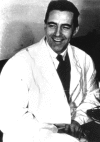The History of Deep Hypothermic Circulatory Arrest in Thoracic Aortic Surgery
- PMID: 26798730
- PMCID: PMC4682724
- DOI: 10.12945/j.aorta.2014.13-049
The History of Deep Hypothermic Circulatory Arrest in Thoracic Aortic Surgery
Abstract
Depending on the extent of aortic disease and surgical repair required, thoracic aortic surgery often involves periods of reduced cerebral perfusion. Historically, this resulted in detrimental neurological dysfunction, and high risk of mortality and morbidity. Over the last half century, rapid improvements have revolutionized aortic surgery. Among these, deep hypothermic circulatory arrest (DHCA) has drastically reduced the risk of mortality and morbidity following surgery on the thoracic aorta. This progress was facilitated by experimental pioneers such as Bigelow, who studied reduced oxygen expenditure consequent on induction of hypothermia in dogs. These encouraging findings led to trials in human cardiac surgery by Lewis in 1952 and further made possible the first successful aortic arch replacement by Denton Cooley and Michael De Bakey. Modern day surgery has come a long way from the use of immersion of the patient in ice baths and other primitive techniques previously described. This paper explores the development of deep hypothermic circulatory arrest from its origins to the present.
Keywords: Aortic aneurysm; Cerebral protection; Deep hypothermic circulatory arrest; History; Thoracic aortic surgery.
Figures
Similar articles
-
Is moderate hypothermic circulatory arrest with selective antegrade cerebral perfusion superior to deep hypothermic circulatory arrest in elective aortic arch surgery?Interact Cardiovasc Thorac Surg. 2016 Sep;23(3):462-8. doi: 10.1093/icvts/ivw124. Epub 2016 May 21. Interact Cardiovasc Thorac Surg. 2016. PMID: 27209532 Review.
-
Mortality and cerebral outcome in patients who underwent aortic arch operations using deep hypothermic circulatory arrest with retrograde cerebral perfusion: no relation of early death, stroke, and delirium to the duration of circulatory arrest.J Thorac Cardiovasc Surg. 1998 Jan;115(1):129-38. doi: 10.1016/s0022-5223(98)70451-9. J Thorac Cardiovasc Surg. 1998. PMID: 9451056
-
Aortic arch reconstruction: deep and moderate hypothermic circulatory arrest with selective antegrade cerebral perfusion.Perfusion. 2017 Jul;32(5):389-393. doi: 10.1177/0267659116688423. Epub 2017 Jan 30. Perfusion. 2017. PMID: 28132587 Clinical Trial.
-
Moderate hypothermia during aortic arch surgery is associated with reduced risk of early mortality.J Thorac Cardiovasc Surg. 2013 Sep;146(3):662-7. doi: 10.1016/j.jtcvs.2013.03.004. Epub 2013 Apr 1. J Thorac Cardiovasc Surg. 2013. PMID: 23558304
-
Deep hypothermic circulatory arrest: real-life suspended animation.Prog Cardiovasc Dis. 2013 Jul-Aug;56(1):81-91. doi: 10.1016/j.pcad.2013.05.009. Prog Cardiovasc Dis. 2013. PMID: 23993241 Review.
Cited by
-
Study on the differential proteomics of rat hippocampal mitochondria during deep hypothermic circulatory arrest.Ann Transl Med. 2021 Feb;9(4):346. doi: 10.21037/atm-21-95. Ann Transl Med. 2021. PMID: 33708973 Free PMC article.
-
Total circulatory arrest as a support modality in congenital heart surgery: review and current evidence.Indian J Thorac Cardiovasc Surg. 2021 Jan;37(Suppl 1):165-173. doi: 10.1007/s12055-020-00930-3. Epub 2020 Mar 9. Indian J Thorac Cardiovasc Surg. 2021. PMID: 33584032 Free PMC article. Review.
-
Efficacy of autologous plateletpheresis in adult aortic surgery: study protocol for a randomised controlled trial.BMJ Open. 2023 Jun 7;13(6):e073341. doi: 10.1136/bmjopen-2023-073341. BMJ Open. 2023. PMID: 37286322 Free PMC article.
-
Renal hypothermia during partial nephrectomy for patients with renal tumours: a randomised controlled clinical trial protocol.BMJ Open. 2019 Jan 3;9(1):e025662. doi: 10.1136/bmjopen-2018-025662. BMJ Open. 2019. PMID: 30610026 Free PMC article.
-
Risk factors of delayed awakening after aortic arch surgery under deep hypothermic circulatory arrest with selective antegrade cerebral perfusion.J Thorac Dis. 2019 Mar;11(3):805-810. doi: 10.21037/jtd.2019.02.01. J Thorac Dis. 2019. PMID: 31019768 Free PMC article.
References
-
- Adams F. The genuine works of Hippocrates. New York: William Wood; 1929.
LinkOut - more resources
Full Text Sources
Other Literature Sources



